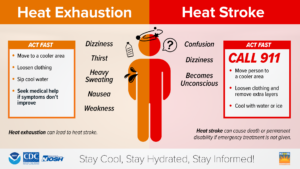You don’t have to be a weather expert to know it is hot outside. With temperatures soaring and summer only halfway through, we have a few more safety tips to beat the heat.
There’s nothing better than enjoying a leisurely day outside, especially with fun activities such as Stars and Stripes and the Fourth of July just around the corner. Whether you are visiting Bicentennial Park, fishing at the Bob Jones Fishing Pier, playing at the Chesapeake Park playground, or hiking at the Nature Center, with the summer temperatures often rising into the triple digits, it’s important to stay vigilant of heat-related safety risks.
Heat exhaustion and heat stroke are common risks during outdoor activities in high temperatures. As you plan your Independence Day activities and summer outings, ensure you know the difference between the two to stay safe in Southlake.
Heat Exhaustion
Heat exhaustion is a response to excessive sweating due to high temperatures. It’s often a precursor to heat stroke and occurs when the body overheats and dehydrates. If you experience heat exhaustion, you may feel fatigued, dizzy, nauseated, sweat excessively, and get a headache.
Heat Stroke
This severe condition occurs when the body loses its ability to control its temperature and cannot cool down. It is a serious heat-related illness that requires immediate medical attention. Heat stroke symptoms include confusion or altered mental status, loss of consciousness, profuse sweating, seizures, and very high body temperature.
While recognizing the symptoms of these two heat-related illnesses is vital, knowing how to prevent them is just as important. Here are some steps to stay safe during the hot summer months.
Knowing the difference between these common heat-related illnesses and following these prevention tips can help you stay safe in Southlake this summer.
Summer is the busiest time of year for Parks and Recreation professionals because it's the best time for families to spend time outside doing what they love!
Nothing beats a lazy day lounging by the pool, exploring a new playground, or training for the Fall Athletic season during the summer months. However, Southlake summers can be unforgiving, and practicing summer safety is crucial.
Here are a few summer safety tips to keep in mind as you get out and explore our incredible recreation amenities this summer.
Dress for Success
Our Southlake residents are always fashionable, but it’s imperative to remember to dress for the heat. Styling light colors is a great way to reflect harmful sun rays while keeping cool. Add some light layers made of breathable fabric for added sun protection. Dress for success when you visit our world-class Southlake parks and playgrounds! Don’t forget to snap a “fit pic” for the gram!
Hydrate, Hydrate, Hydrate
Don’t forget to drink water when spending time outside! Drinking enough water is vital any time of the year, but it is essential when it’s hot. Start your day with a glass in the morning and add another to every meal. Grab a fun reusable bottle to take to the pool, the playground, and the winding trails of the Bob Jones Nature Center and Preserve. Our Parks professionals always carry extra water around, and you should too!
Timing is Everything
The summer days are long, and the number of fun activities is endless. If spending time outdoors is part of your daily routine, adjust your schedule to avoid the hottest parts of the day. Early mornings and evenings are the best time of day to schedule a tennis or pickleball match with friends, walk your dog, or take your little one to the park! Mid-mornings to early afternoons can be the hottest hours of the day. Beat the heat during that time by checking out Champions Club and enjoying our indoor Aquatics Center!
Apply and Reapply
Finally, apply sunscreen! Your skin is your biggest organ, so show it some big love this summer by generously applying sunscreen when you go out. Sweat and water can limit the benefits of sunscreen, so make sure you reapply every two hours for maximum protection.
There are many ways to stay cool and safe in Southlake this summer. Remember these tips, and you'll create many life-long memories!
Citizens of Southlake and North Texas are no strangers to high temperatures and humidity during the summer months. Every year, people across the country die due to heat-related illnesses, so it’s important to know what you can do to prevent heat exhaustion and heat stroke. That's why the City of Southlake Office of Emergency Management (OEM) wants you to “Beat the Heat” this summer and learn precautions that can be taken during excessive heat.
Below you will find basic information on heat injury prevention and resources available to the community to stay cool.
Extreme heat brings with it the possibility of heat-related illnesses. The following table lists these illnesses, their symptoms, and the first aid treatment.
Symptoms
Painful spasms, usually in leg and abdominal muscles; heavy sweating
First Aid
Symptoms
Heavy sweating but skin may be cool, pale, or flushed - weak pulse. Average body temperature is possible, but the temperature will likely rise. Fainting or dizziness, nausea, vomiting, exhaustion, and headaches are possible.
First Aid
A severe medical emergency
Symptoms
High body temperature (105+); hot, red, dry skin; rapid, weak pulse; and rapid shallow breathing. The victim will probably not sweat unless they were sweating from recent strenuous activity. Possible unconsciousness.
First Aid
Symptoms
Skin redness and pain, possible swelling, blisters, fever, headaches
First Aid
Tracking the power grid capacity: https://www.ercot.com/
How to track power outages/report power outages: